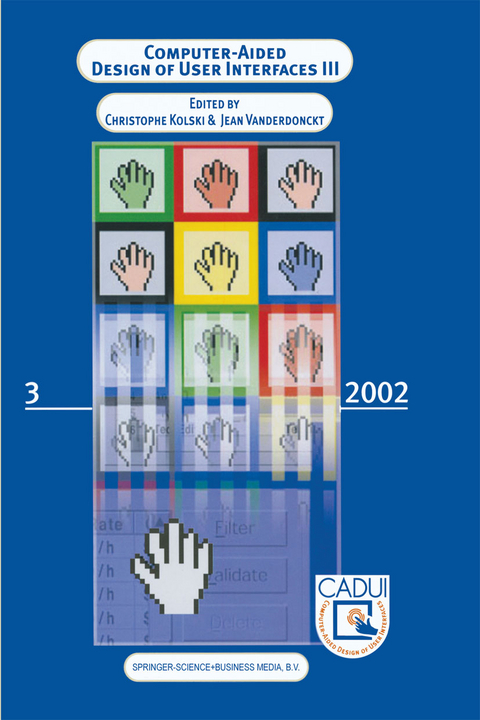
Computer-Aided Design of User Interfaces III
Springer (Verlag)
978-94-010-3915-4 (ISBN)
Advances in electronics, communications, and the fast growth of the Internet have made the use of a wide variety of computing devices an every day occurrence. These computing devices have different interaction styles, input/output techniques, modalities, characteristics, and contexts of use. Furthermore, users expect to access their data and run the same application from any of these devices. Two of the problems we encountered in our own work [2] in building VIs for different platforms were the different layout features and screen sizes associated with each platform and device. Dan Ol sen [13], Peter Johnson [9], and Stephen Brewster, et al. [4] all talk about problems in interaction due to the diversity of interactive platforms, devices, network services and applications. They also talk about the problems associ ated with the small screen size of hand-held devices. In comparison to desk top computers, hand-held devices will always suffer from a lack of screen real estate, so new metaphors of interaction have to be devised for such de vices. It is difficult to develop a multi-platform user interface (VI) without duplicating development effort. Developers now face the daunting task to build UIs that must work across multiple devices. There have been some ap proaches towards solving this problem of multi-platform VI development in cluding XWeb [14]. Building "plastic interfaces" [5,20] is one such method in which the VIs are designed to "withstand variations of context of use while preserving usability".
Invited speakers.- 1. Computer-Aided Design of User Interfaces by Example.- 2. Foundations for a Theory of Contextors.- 3. WSXL: A Web Services Language for Integrating End-User Experience.- Specification of User Interfaces.- 4. From Formal Specifications to Secure Implementations.- 5. Just-UI: A User Interface Specification Model.- 6. DTS-Edit: an Interactive Development Environment for Structured Dialog Applications.- Task Scenarios: Elicitation and Derivation.- 7. Automatically Eliciting Task Models from Written Task Narratives.- 8. From Usage Scenarios to User Interface Elements in a Few Steps.- 9. Exploring Design Heuristics for User Interface Derivation from Task and Domain Models.- Model-Based Approaches.- 10. A User Modeling Design Tool Based on a Cognitive Architecture for Comparing Interfaces.- 11. A Model-Guided and Task-Based Approach to User Interface Design Centered in a Unified Interaction and Architectural Model.- 12. Using User Interface Models in Design.- User Interfaces for Multiple Contexts of Use.- 13. One Model, Many Interfaces.- 14. Combining Handcrafting and Automatic Generation of User-Interfaces for Pervasive Devices.- 15. Concepts for Generating Multi-User Interfaces Including Graphical Editors.- Domain-Oriented Model-Based Approaches.- 16. DIGBE : Online Model-Based Design Automation.- 17. Meeting Activity Theory through Task-Based and User-Oriented Development of User Interfaces.- 18. Model-Based Interactive Prototyping of Highly Interactive Applications.- Innovative Model-Based Approaches.- 19. Modeling Style of Work as an Aid to the Design and Evaluation of Interactive Systems.- 20. An Online Multimedia System for Learning to Design User Interfaces.- 21. UML and Interactive Systems, Another Step Forward.- UIML- and XML-Based User Interfaces.- 22. Building Multi-Platform User Interfaces with UIML.- 23. Development of an UIML Renderer for Different Target Languages.- 24. Generic Interface Descriptions using XML.- User Interface Migration: Forward and Backward.- 25. Specifying User Interfaces for Runtime Modal Independent Migration.- 26. Reverse Engineering Interaction Plans for Legacy Interface Migration.- 27. Recovering Alternative Presentation Models of a Web Page with VAQUlTA.- Usability Engineering and the Web.- 28. Evidence-Based Usability Engineering.- 29. A Framework and a Language for Usability Automatic Evaluation of Web Sites by Static Analysis of HTML Source Code.- 30. First Steps Towards Task-Related Web User Interfaces.- Agent-Based User Interfaces.- 31. Cooperative Agents Design in a Technological Watch Context.- 32. A Multi-Agent Approach to Cooperative Work.- 33. Agent Oriented Specification of Interactive Systems: Basic Principles and Industrial Case Study.
| Zusatzinfo | X, 389 p. |
|---|---|
| Verlagsort | Dordrecht |
| Sprache | englisch |
| Maße | 160 x 240 mm |
| Themenwelt | Mathematik / Informatik ► Informatik ► Betriebssysteme / Server |
| Mathematik / Informatik ► Informatik ► Grafik / Design | |
| Informatik ► Software Entwicklung ► User Interfaces (HCI) | |
| Informatik ► Theorie / Studium ► Künstliche Intelligenz / Robotik | |
| ISBN-10 | 94-010-3915-1 / 9401039151 |
| ISBN-13 | 978-94-010-3915-4 / 9789401039154 |
| Zustand | Neuware |
| Informationen gemäß Produktsicherheitsverordnung (GPSR) | |
| Haben Sie eine Frage zum Produkt? |
aus dem Bereich


